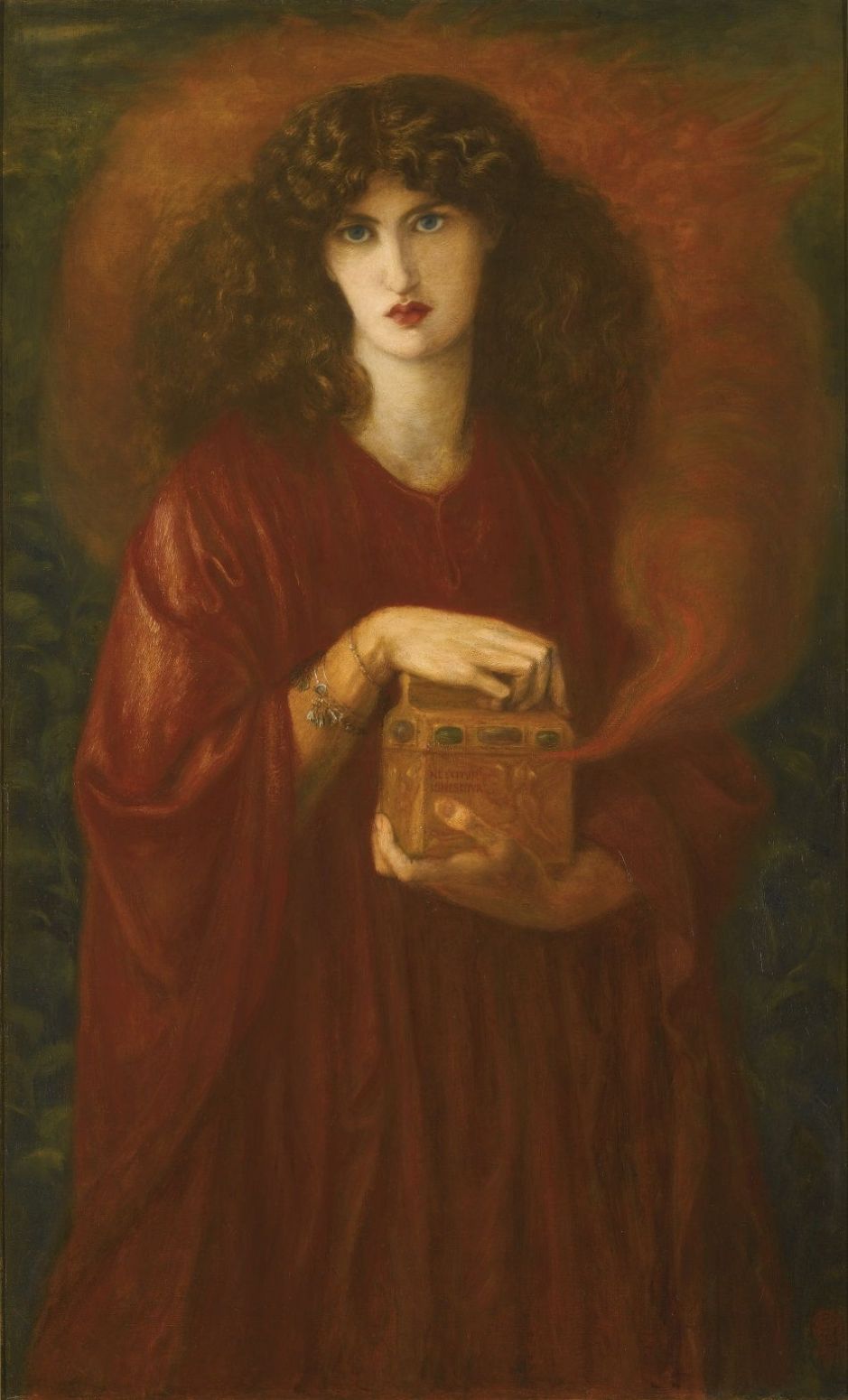There’s just one frequently painted story that’s centred on a box, and is famous enough to have entered English and other languages: the myth of Pandora’s box. However, as far as paintings are concerned, this was an unusual theme until the nineteenth century, and is seldom faithful to the original myth, in which Pandora had a jar rather than a box.
One reason for Pandora’s late discovery is that her myth appears in less accessible sources: Hesiod’s Theogony and Works and Days, among the oldest of Greek anthologies, dating back to around 750 BCE, and not as widely used as Ovid’s Metamorphoses.
The story of Pandora and her ‘box’ is told most fully in Works and Days, where she’s the original woman, created by Hephaestus (Roman: Vulcan) for Zeus, as punishment for humans receiving the gift of fire that had been stolen by Prometheus. After she was formed from earth by Hephaestus, other gods gave her properties to determine her nature. Athena dressed her in a silvery gown, and taught her needlecraft and weaving. Aphrodite shed grace on her head, together with cruel longing and cares. Hermes gave her a shameful mind and deceitful nature, together with the power of speech, including the ability to tell lies. Other gifts were provided by Persuasion, the Charities, and the Horae.
Pandora carried with her a large earthenware jar (pithos, in Greek) containing toil and sickness that bring death to men, diseases, and a myriad of other pains. Zeus gave her as a gift to Epimetheus, brother of Prometheus. She then opened her jar, and released its evils into the earth and sea. All that remained in her jar was Hope, who stayed under its lip.

As with other classical myths, at the time that Jean Cousin painted Eva Prima Pandora, in about 1550, it had been mixed with Christian religious narrative, in this case of Eve and the Fall of Mankind. No longer clothed in Athena’s silvery gown, Eve/Pandora lies naked, propped against a human skull. Her left hand clutches the dreaded jar, which she hasn’t yet opened. Her right hand holds a fruiting sprig of the apple tree, an allusion to the traditional Biblical story of Eve. Coiled around her left arm is a serpent, another reference to the Fall.

It was the now-forgotten Henry Howard who first painted The Opening of Pandora’s Vase in 1834. Pandora crouches to duck the torrent of woe, evil and pain streaming from the jar, as Epimetheus tries in vain to reseal its lid. This adheres faithfully to Hesiod’s account.
There are two independent sources that may have been responsible for Pandora’s jar becoming a box: a mistranslation by Erasmus in 1508 that resulted in other arts adopting the box, and conflation with the myth of Psyche, who had a box that she couldn’t open. The switch from jar to box happened some time between about 1834 and 1860, when Pandora started to become a popular theme for paintings.

This undated painting attributed to Louis Hersent of Pandora Reclining in a Wooded Landscape gives this revised account, with the box firmly shut in Pandora’s right hand, and the motif is an uncommitted combination of landscape, nude figure, and vague narrative.

Dante Gabriel Rossetti’s first painting of Pandora, completed in 1871, shows a moody, brooding Pandora, modelled by Jane Morris. She has just cracked open the lid of the jewelled casket held in her left hand, and it emits a stream of noxious red smoke. As this coils around her head, winged figures appear in the fumes. Rossetti’s source for the story of Pandora was most probably Lemprière’s dictionary of classical mythology, one of the sources to refer erroneously to Pandora’s box, not jar. The inscription on the side of the jewel casket reads “Nascitur ignescitur”, meaning born of flames.

Jules Lefebvre was another artist who painted Pandora more than once. This initial version from 1872 shows her walking with the fateful box held in both hands, its lid firmly shut. Ominous smoke rises from a series of fumaroles in the ground around her. She is nude, wears an unusual coronet, and there is a six-pointed star above her head.

Odilon Redon’s finished oil painting of Pandora from about 1914 shows her surrounded by a garden of exquisite and exotic blooms, referring to Eve’s Paradise before the Fall. She holds her box to her bosom, in the midst of succumbing to temptation to open it, but Redon stops just short of showing its evils pouring out.

One of his lesser-known paintings, John William Waterhouse’s Pandora from 1896 is a major depiction of this myth, and one of the most complete. Set by a small brook in a dark, primeval forest, her box has become a large gold chest encrusted with precious stones and decorated with mythological motifs. Pandora kneels by its side, peeking inside as she carefully raises its lid. Even this tentative glimpse is sufficient to release its stream of ills, of which she appears unaware.

I have been unable to find a date for this presumed illustration by the great Arthur Rackham of Pandora, but suspect it was made around the turn of the twentieth century, and intended to accompany a British retelling of this myth. Pandora is young and innocent in her nakedness, and gazes up in awe at the batlike demons as they escape from the open lid of her large wooden chest, unaware of what she is unleashing in her curiosity.

Thomas Benjamin Kennington shows Pandora (1908) in the final phase of regret and sorrow, after the evils have all been released. Her box, now empty, and with no sign of Hope, rests on her thigh. She hangs her head in shame, resting it on her right hand as she weeps at what she has done. Unfortunately the released demons shown at the left edge are so dark that they are hard to see.
Tomorrow I will show some boxes in more prosaic settings.

